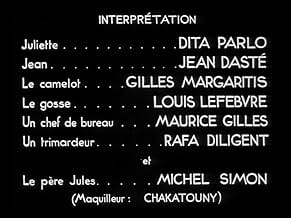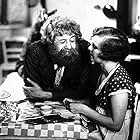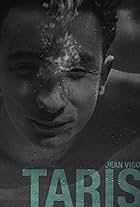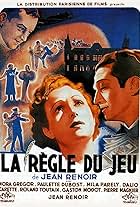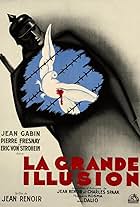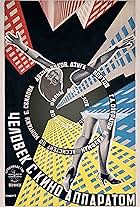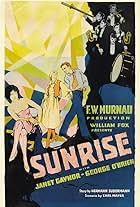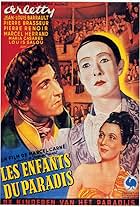Newly married couple Juliette and a ship captain Jean struggle through marriage as they travel on the L'atalante along with the captain's first mate Le père Jules and a cabin boy.Newly married couple Juliette and a ship captain Jean struggle through marriage as they travel on the L'atalante along with the captain's first mate Le père Jules and a cabin boy.Newly married couple Juliette and a ship captain Jean struggle through marriage as they travel on the L'atalante along with the captain's first mate Le père Jules and a cabin boy.
- Awards
- 1 nomination
Raphaël Diligent
- Le trimardeur (tramp
- (as Rafa Diligent)
- …
René Blech
- Best Man at Wedding
- (uncredited)
Lou Bonin
- Passenger at Railway Station
- (uncredited)
Jacques B. Brunius
- Policeman with a Bicycle
- (uncredited)
Fanny Clair
- Juliette's Mother
- (uncredited)
Fanny Clar
- La mère de Juliette
- (uncredited)
Charles Dorat
- Thief
- (uncredited)
Paul Grimault
- Passenger at Railway Station
- (uncredited)
Genya Lozinska
- Fortune Teller
- (uncredited)
Gen Paul
- Master of Ceremonies at Wedding
- (uncredited)
Jacques Prévert
- Passenger at Railway Station
- (uncredited)
Storyline
Did you know
- GoofsAfter jumping overboard and swimming, as Jean is climbing the rope up the side of the barge, he is (expectedly) dripping wet. The scene cuts and he is on board approaching Le père Jules and Le gosse from behind, and he has wet clothes, but no water dripping from them or his hair.
- Quotes
Le camelot (peddler): My dear friends, so kind of you to come. We were waiting for you before we served the biscuits dry as the duchess's pussy.
- Alternate versions1934-04-25 --- Jean Vigo's authorized cut before his death, at 89 min running time, shown to exhibitors and distributors mostly, at Palais Rochechouart, Paris, France. This version is lost.
- ConnectionsEdited into Cinéastes de notre temps: Jean Vigo (1964)
Featured review
My big problem with "L'Atalante" is how much of what we see and hear was really Jean Vigo's intention (as he didn't finish it) when he was making it? The restored version is the only version and was reconstructed from many disparate bits about 15 years ago, meaning it has had running order interpretations foisted upon it. I think most of the film we see came from the BFI in London, remixed with other clips into some kind of logical sequence by Gaumont in Paris and sold as a Forgotten Masterpiece.
Well, if you can call such luck ending up as a masterpiece it was purely unintentional by Vigo - he didn't see what we do now.
What we have though is definitely a series of relentlessly beautiful, thought-provoking, impressionistic black and white images hung together for 87 minutes with a very flimsy story of 3 people on a barge. The kid was background fluff and doesn't really count. Simon was his usual farcical self, I wish he'd been background as well. Daste and Parla were both later in "La Grande Illusion", can you really forget her as the German widow Elsa in favour of this? The framings and compositions are wonderful to see - how important was it to include distant shots of power stations, cranes etc? Why did Daste stare right into the underwater camera? How come every available surface seems uncomfortable or strewn with bizarre objects or people? Why just the one short aerial shot? And so many other questions which are either pointless or beyond my intelligence; somebody somewhere must know!
I find every time I watch "L'Atalante" it grows on me - I thought it was pants in '91, now I think it's brill! We all move at different speeds - some people will never be able to see this as anything but boring while some people thought it was a classic before they saw it! Whereas I'm still on the voyage of discovery with this one and will definitely watch it again, but not as an indispensable film, more as akin to a trip to the Art Gallery.
Well, if you can call such luck ending up as a masterpiece it was purely unintentional by Vigo - he didn't see what we do now.
What we have though is definitely a series of relentlessly beautiful, thought-provoking, impressionistic black and white images hung together for 87 minutes with a very flimsy story of 3 people on a barge. The kid was background fluff and doesn't really count. Simon was his usual farcical self, I wish he'd been background as well. Daste and Parla were both later in "La Grande Illusion", can you really forget her as the German widow Elsa in favour of this? The framings and compositions are wonderful to see - how important was it to include distant shots of power stations, cranes etc? Why did Daste stare right into the underwater camera? How come every available surface seems uncomfortable or strewn with bizarre objects or people? Why just the one short aerial shot? And so many other questions which are either pointless or beyond my intelligence; somebody somewhere must know!
I find every time I watch "L'Atalante" it grows on me - I thought it was pants in '91, now I think it's brill! We all move at different speeds - some people will never be able to see this as anything but boring while some people thought it was a classic before they saw it! Whereas I'm still on the voyage of discovery with this one and will definitely watch it again, but not as an indispensable film, more as akin to a trip to the Art Gallery.
- Spondonman
- Aug 28, 2004
- Permalink
- How long is L'Atalante?Powered by Alexa
Details
- Release date
- Country of origin
- Languages
- Also known as
- Atalante
- Filming locations
- Bassin de la Villette, Paris 19, Paris, France(Lake crossed by the barge.)
- Production companies
- See more company credits at IMDbPro
Box office
- Gross worldwide
- $9,505
- Runtime1 hour 29 minutes
- Color
- Aspect ratio
- 1.37 : 1
Contribute to this page
Suggest an edit or add missing content









